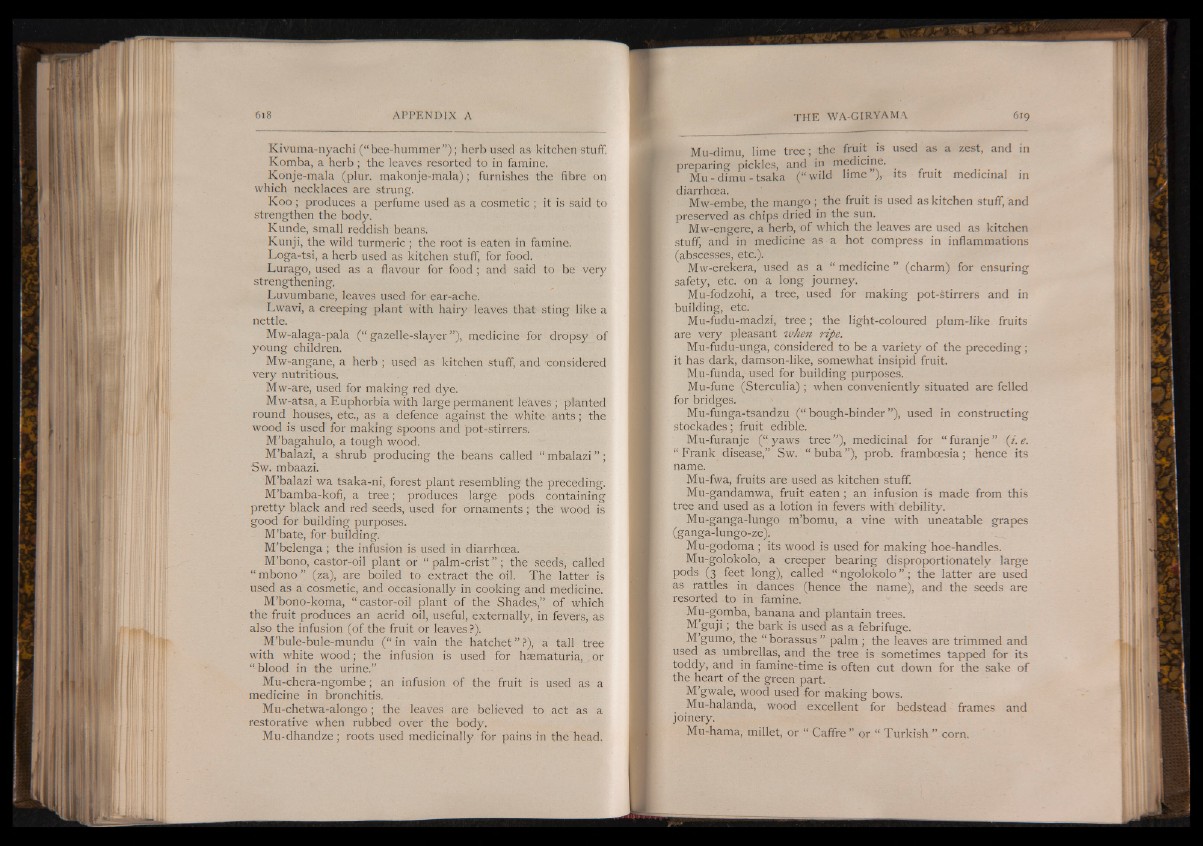
APPENDIX A
Kivuma-nyachi (“ bee-hummer”); herb used as kitchen stuff-,
Komba, a herb; the leaves resorted to in famine.
Konje-mala (plur. makonje-mala); furnishes the fibre on
which necklaces are strung.
K o o ; produces a perfume used as a cosmetic ; it is said to
strengthen the body.
Kunde, small readish beans.
Kunji, the wild turmeric ; the root is eaten in famine.
Loga-tsi, a herb used as kitchen stuff, for food.
Lurago, used as a flavour for food; and said to be very
strengthening.
Luvumbane, leaves used for ear-ache.
Lwavi, a creeping plant with hairy leaves that sting like a
nettle.
Mw-alaga-pala (“ gazelle-slayer ”), medicine for dropsy of
young children.
Mw-angane, a herb ; used as kitchen stuff, and -considered
very nutritious.
Mw-are, used for making red dye.
Mw-atsa, a Euphorbia with large permanent leaves ; planted
round houses, etc., as a defence against the white ants; the
wood is used for making spoons and pot-stirrers.
M’bagahulo, a tough wood.
M’balazi, a shrub producing the beans called “ mbalazi ” ;
Sw. mbaazi.
M’balazi wa tsaka-ni, forest plant resembling the preceding.
M’bamba-kofi, a tree; produces large pods containing
pretty black and red seeds, used for ornaments; the wood is
good for building purposes.
M’bate, for building.
M’belenga; the infusion is used in diarrhoea.
M’bono, castor-oil plant or “ palm-crist ” ; the seeds, called
“ mbono ” (za), are boiled to extract the oil. The latter is
used as a cosmetic, and occasionally in cooking and medicine.
M’bono-koma, “ castor-oil plant of the Shades,” of which
the fruit produces an acrid oil, useful, externally, in fevers, as
also the infusion (of the fruit or leaves ?).
M’bule-bule-mundu (“ in vain the hatchet ” ?), a tall tree
with white wood; the infusion is used for haematuria, . or
“ blood in the urine.”
Mu-chera-ngombe; an infusion of the fruit is used as a
medicine in bronchitis.
Mu-chetwa-alongo; the leaves are believed to act as a
restorative when rubbed over the body.
Mu-dhandze; roots used medicinally for pains in the head,
THE WA-GIRYAMA 619
Mu-dimu, lime tree; the fruit is used as a zest, and in
preparing pickles, and in medicine.
Mu - dimu - tsaka (“ wild lime ), its fruit medicinal in
diarrhoea.
Mw-embe, the mango ; the fruit is used as kitchen stuff, and
preserved as chips dried in the sun.
Mw-engere, a herb, of which the leaves are used as kitchen
stuff, and in medicine as a hot compress in inflammations
(abscesses, etc.).
Mw-erekera, used as a “ medicine ” (charm) for ensuring
safety, etc. on a long journey.
Mu-fodzohi, a tree, used for making pot-stirrers and in
building, etc.
Mu-fudu-madzi, tree; the light-coloured plum-like fruits
are very pleasant when ripe.
Mu-fudu-unga, considered to be a variety of the preceding;
it has dark, damson-like, somewhat insipid fruit.
Mu-funda, used for building purposes.
Mu-fune (Sterculia); when conveniently situated are felled
for bridges.
Mu-funga-tsandzu (“ bough-binder ”), used in constructing
stockades; fruit edible.
Mu-furanje (“ yaws tree ”), medicinal for “ furanje ” (i. e.
I Frank disease,” Sw. “ buba ”), prob. framboesia; hence its
name.
Mu-fwa, fruits are used as kitchen stuff.
Mu-gandamwa, fruit eaten; an infusion is made from this
tree and used as a lotion in fevers with debility.
Mu-ganga-lungo m’bomu, a vine with uneatable grapes
(ganga-lungo-ze);
Mu-godoma ; its wood is used for making hoe-handles.
Mu-golokolo, a creeper bearing disproportionately large
pods (3 feet long), called “ ngolokolo” ; the latter are used
as rattles in dances (hence the name), and the seeds are
resorted to in famine.
Mu-gomba, banana and plantain trees.
M’gu ji; the bark is used as a febrifuge.
M’gumo, the “ borassus ” palm ; the leaves are trimmed and
used as umbrellas, and the tree is sometimes tapped for its
toddy, and in famine-time is often cut down for the sake of
the heart of the green part.
M’gwale, wood used for making bows.
Mu-halanda, wood excellent for bedstead frames and
joinery.
Mu-hama, millet, or “ Caffre ” or “ Turkish ” corn.